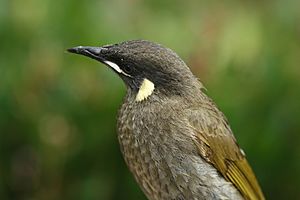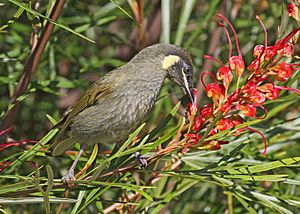Lewin's honeyeater facts for kids
Quick facts for kids Lewin's honeyeater |
|
|---|---|
 |
|
| Conservation status | |
| Scientific classification | |
| Genus: |
Meliphaga
|
| Species: |
lewinii
|
The Lewin's honeyeater (Meliphaga lewinii) is a special bird found along the eastern coast of Australia. You can spot it by its unique pale yellow, semicircular ear-patch. This bird was named after John Lewin, a famous Australian artist.
Contents
About the Lewin's Honeyeater
Lewin's honeyeaters are small to medium-sized birds, usually about 20 to 22 centimeters (8 to 9 inches) long. They are mostly dark greenish-grey. A cool feature is their creamy yellow "gape," which are the soft corners of their mouth.
Their most noticeable feature is the large, yellowish, crescent-shaped patches on their ears. These patches help tell them apart from other honeyeaters. When they fly, you might see the light yellow edges of their flight feathers. They have a black beak and blue-grey eyes.
Both male and female Lewin's honeyeaters look very similar. Young birds also look like adults, but their eyes are brown instead of blue-grey. You'll often hear them before you see them! Their loud, strong call sounds like a "machine gun" rattling, and it can be heard from far away. This sound helps you know they are nearby.
Where They Live and Their Home
The Lewin's honeyeater loves the wetter parts of eastern Australia. You can find them from northern Queensland all the way down to central Victoria. They live in rainforests and wet sclerophyll forests (which are forests with tough, leathery-leaved trees). Sometimes, they visit more open woodlands too.
These birds are quite common, and their calls are a familiar sound in these areas. They tend to stay in the same place all year. However, some might move to lower areas during the colder winter months. This is called "altitudinal migration."
What Lewin's Honeyeaters Eat
Lewin's honeyeaters mostly enjoy eating fruits, especially berries and small fruits. But they also eat insects and nectar from flowers. You'll usually see them alone, but sometimes they gather in small groups of up to 10 birds.
They like to feed in the upper branches and on the trunks of trees. They are also good at catching insects while flying!
Reproduction and Life Cycle
Lewin's honeyeaters usually breed between September and January. They build a large, cup-shaped nest using plants and other materials. They hold the nest together with spider webs and line it with soft stuff to make it comfy.
The female bird lays two to three oval-shaped eggs. These eggs hatch after about 14 days. The young birds stay in the nest for another 14 days before they are ready to fly out. Both parents help take care of the young birds, though it's not fully known who does what in building the nest or sitting on the eggs.
See also
 In Spanish: Mielero de Lewin para niños
In Spanish: Mielero de Lewin para niños




